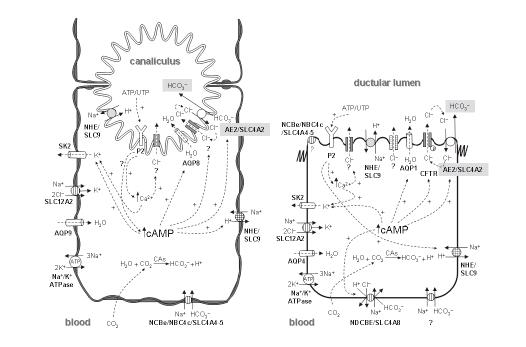Copyright
©2006 Baishideng Publishing Group Co.
World J Gastroenterol. Jun 14, 2006; 12(22): 3496-3511
Published online Jun 14, 2006. doi: 10.3748/wjg.v12.i22.3496
Published online Jun 14, 2006. doi: 10.3748/wjg.v12.i22.3496
Figure 1 The major ion carriers implicated in pHi regulation and secretion of bicarbonate to bile from liver cells.
A: Hepatocytes; B: Cholangiocytes.
Figure 2 Hormonal stimulation of bicarbonate excretion from hepatocytes and cholangiocytes.
A: In hepatocytes, glucagon may induce an exocytic trafficking of vesicles with the anion exchanger AE2/SLC4A2 and the water channel AQP8, which can results in canalicular bicarbonate-rich hydrocholeresis. MRP2/ABCC2, while being a carrier for organic anions like glutathione rather than an inorganic ion transporter, is hereby depicted because of its possible colocalization with the other two flux proteins; B: In cholangiocytes, secretin induces trafficking of vesicles with the chloride channel CFTR, the anion exchanger AE2/SLC4A2, and the water channel AQP1, and further exocytosis to the lumenal membrane of these cells, which results in ductal bicarbonate-rich hydrocholeresis.
- Citation: Banales JM, Prieto J, Medina JF. Cholangiocyte anion exchange and biliary bicarbonate excretion. World J Gastroenterol 2006; 12(22): 3496-3511
- URL: https://www.wjgnet.com/1007-9327/full/v12/i22/3496.htm
- DOI: https://dx.doi.org/10.3748/wjg.v12.i22.3496










